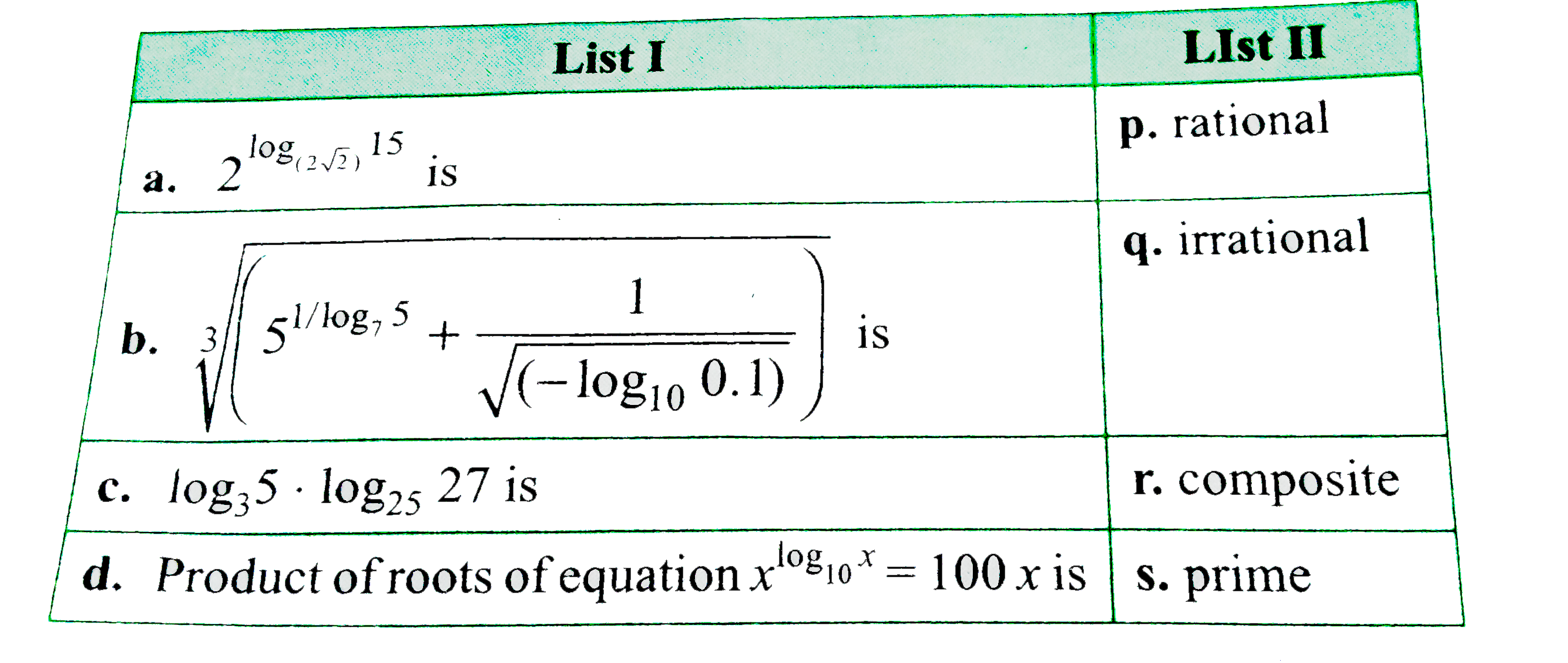Match the following List I to List II

The correct Answer is:a→q;b→p,s;c→p;d→p,r
a. 2log(2√2)15=2log23/215=22/3log215=2log2152/3=152/3
b. 3
⎷(51/log75+1√(−log100.1))
=3
⎷⎛⎜
⎜⎝5log571√(log100.1−1)⎞⎟
⎟⎠
3
⎷(7+1√log1010)=3√(7+1)=2
c. log35⋅log2527
=log5log27log3log25=log5log3×32log3log532
d. (log10x)2=log100x=2+log10x
Putting logx=t, we get t2=2+t
ort2−t−2=0
⇒t=2ort=−1
⇒log10x=2orlog10x=−1
⇒x=100orx=1/10
Hence, the product of roots is 10.
Topper's Solved these Questions
- LOGARITHM AND ITS PROPERTIESBOOK - CENGAGE ENGLISHCHAPTER - LOGARITHM AND ITS PROPERTIESEXERCISE - Numerical Value Type
20 Videos
- LOGARITHM AND ITS PROPERTIESBOOK - CENGAGE ENGLISHCHAPTER - LOGARITHM AND ITS PROPERTIESEXERCISE - JEE MAIN
1 Videos
- LOGARITHM AND ITS PROPERTIESBOOK - CENGAGE ENGLISHCHAPTER - LOGARITHM AND ITS PROPERTIESEXERCISE - Linked Comprehension Type
6 Videos
- LOGARITHM AND ITS APPLICATIONS BOOK - CENGAGE ENGLISHCHAPTER - LOGARITHM AND ITS APPLICATIONS EXERCISE - Subjective Type
9 Videos
- MATHMETICAL REASONINGBOOK - CENGAGE ENGLISHCHAPTER - MATHMETICAL REASONINGEXERCISE - Archives
10 Videos
Similar Questions
Let a function f(x)=[x]{x}−|x| where [.],{.} are greatest integer and fractional part respectively then match the following List-I with List-II.


View SolutionMatch the following in List-I with List II and select the corect option :-
List−IList−IIaKP=QiAlways nonspontaneousbT>ΔH/ΔSiiIsothrmal processcΔH=+veΔS=−veiiiEquilibriumdq=−veivspontaneous and endothermic
View SolutionMatch the following
List -I List - II A) False fruit I) BananaB) Pathenocarpic fruit II) Jack fruitC) Aggregate fruit III) Annona(D) Composite fruit IV) Pea V) Apple
View SolutionMatch the following
List - IList - IIA) TrichomesI) CambiumB) Root hairsII) LeavesC) MesophyllIII) UnicellularD) DicotyledonousIV) Epidermal hairs stem
View SolutionMatch the following
{:("List - I", "List - II"),("(A) Taeniophyllum","(I) Epiphyte"),("(B) Ground nut","(II) Mangrove plant"),("(C) Vanda","(III) Photosynthetic "),(," roots"),("(D) Rhizophora","(IV) Nodular roots"),(,"(V) Stilt roots"):}
View SolutionMatch the following.
List-IList-III) Glands without ductsA) Cerimunous glandII) Isolated unicellular glandsB) Islets of langerhansIII) Glands with ductsC) Goblet cellsIV) Glands that produce waxD) Salivary glands
View SolutionMatch the following
List - IList - II1) EpidermisI) Bean shaped cells2) CuticleII) Stomatal aperture, guard cells and subsidiary cells3) Stomatal apparatusIII) Thick waxy layer4) Guard cellsIV) Outermost layer
View SolutionMatch the following.
List-IList-III) Tight junctionsA) Cement neighbouring cellsII) Gap junctionsB) Stop leakage of substancesIII) Adhering junctionsC) rapid transfer of ionsIV) EpitheliaD) Upon growing
View SolutionMatch the following
List - I List - IIA) Rachis1) Vascular tissues B) China roseII)Peduncle growth islimitedC) VeinsIII) Alternate phyllotaxyD) Cymose IV)Pinnately compound inflorescence leaf
View SolutionMatch the following
Match list I (Type of ore) with list II.

View Solution
